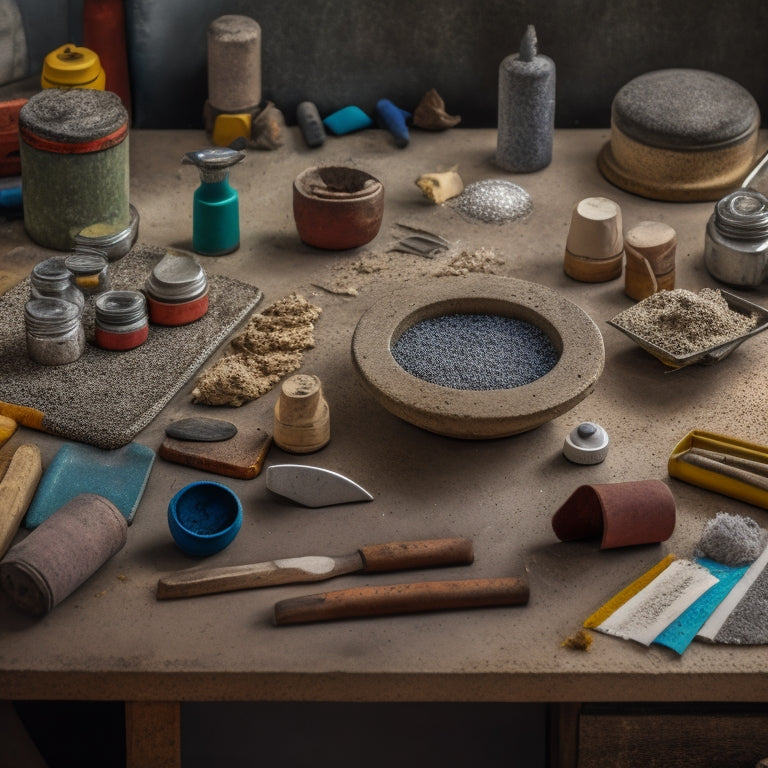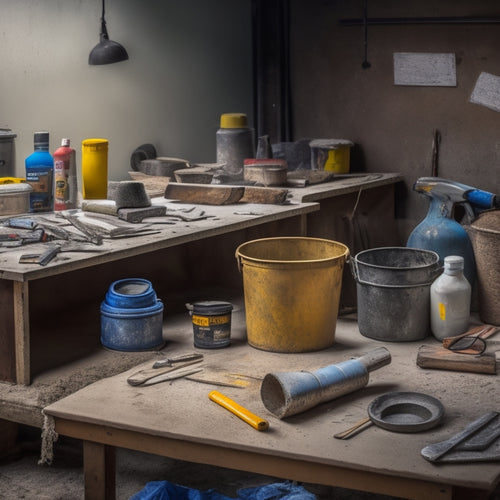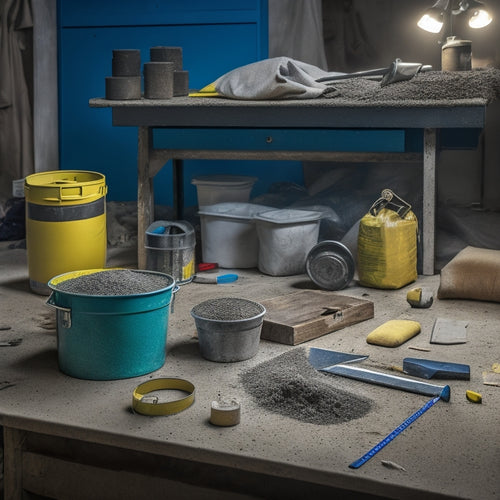
What Tools Do You Need for Decorative Concrete
Share
You'll need a thorough set of specialized tools to achieve high-quality, professional-looking decorative concrete results. Essential tools include stamp mats, tamping tools, edging and joint tools, and color hardener application tools, depending on the specific project requirements and desired aesthetic. A well-stocked inventory of concrete stamp mats, edgers, joint trowels, and color hardener application tools is vital for achieving unique custom designs and professional finishes. From safety gear to measuring and mixing equipment, having the right tools is only the starting point – mastering techniques and understanding how to use them effectively is key to achieving exceptional results, and that's where your journey begins.
Key Takeaways
• Essential tools for decorative concrete include stamp mats, tampers, texturing skins, and edging and joint tools to achieve high-quality results.
• Tamping tools, such as hand tampers and bull floats, are necessary for compacting concrete and ensuring even pressure distribution.
• A variety of stamp mat designs, including brick, stone, and wood grain, are required to offer clients different texture and pattern options.
• Safety gear, such as protective eyewear, respiratory masks, and gloves, is crucial for concrete workers to prevent injuries and health risks.
• Measuring and mixing equipment, including digital scales and mixing buckets, are necessary for accurately preparing and applying decorative concrete materials.
Essential Tools for Stamping Concrete
You'll need a set of vital tools to achieve professional-looking stamped concrete patterns, including a stamp mat, tamper, and texturing skin. These tools will help you master various stamping techniques, from subtle to bold, and create texture variations that mimic natural stone or other materials.
The stamp mat is the star of the show, providing the pattern and texture to your concrete. It's available in different designs, such as brick, stone, or wood, and can be used to create complex patterns or simple textures.
The tamper is used to compact the concrete and guarantee a solid bond between the stamp mat and the surface. This is essential for achieving a crisp, detailed pattern.
The texturing skin adds an extra layer of realism to your stamped concrete. It's a thin, flexible sheet that's applied to the stamp mat, giving your concrete a more natural, organic look.
With these vital tools, you'll be able to experiment with different stamping techniques and texture variations to achieve unique, professional-looking results.
Must-Have Tamping Tool Options
Selecting the right tamping tool is critical to achieving a solid bond between the stamp mat and the concrete surface, and several must-have options are available to help you get the job done efficiently.
When it comes to tamping techniques, you'll want to choose a tool that allows for even pressure distribution and effective material consolidation.
Here are three must-have tamping tool options to evaluate:
-
Hand Tamper: A hand tamper is a versatile tool that's perfect for smaller projects and tight spaces. Its compact design and lightweight construction make it easy to maneuver and control.
-
Bull Float: A bull float is a larger, heavier tool that's ideal for bigger projects and open areas. Its flat, broad blade is designed for efficient tamping and smoothing.
-
Tamping Rod: A tamping rod is a long, sturdy tool that's used to compact and consolidate tamping materials. Its length and rigidity make it perfect for reaching into corners and tight spaces.
Concrete Stamp Mat Inventory
Frequently, a well-stocked concrete stamp mat inventory is crucial to achieving a wide range of textures and patterns in your decorative concrete projects. You'll want to have a variety of mats on hand to accommodate different decorative pattern techniques and concrete texture options. A basic inventory should include mats with different patterns, such as brick, stone, and wood grain, as well as mats with various textures, like smooth, rough, and distressed.
Having a diverse inventory allows you to offer clients more design options and flexibility. You can create unique, custom designs by combining different mats and techniques. For instance, you can use a stone-patterned mat to create a natural-looking patio, or a wood-grain mat to give a walkway a rustic feel.
When selecting mats, consider the type of project you're working on, the desired aesthetic, and the level of detail required. It's also important to maintain and clean your mats regularly to guarantee they continue to produce high-quality results.
With a well-stocked concrete stamp mat inventory, you'll be equipped to tackle a wide range of decorative concrete projects and deliver exceptional results.
Edger and Joint Tool Essentials
When working with decorative concrete, having the right edger and joint tools is essential for creating clean, defined edges and precise joints that enhance the overall appearance of your project. These tools help you achieve professional-looking results by allowing you to control the flow of concrete, create crisp edges, and define joints.
Here are three essential edger and joint tools you'll need:
-
Edger: A must-have for creating clean, defined edges. Edgers come in different types, such as steel, plastic, or rubber, and are used to shape and form the concrete.
-
Joint trowel: Used to create precise joints, joint trowels are typically made of steel or aluminum and come in various widths.
-
Joint cutter: A specialized tool for cutting and shaping joints, joint cutters are available in different types, including manual and power-driven models.
Mastering edger techniques and selecting the right joint tool types will make a significant difference in the quality of your decorative concrete project.
Color Hardener Application Tools
You'll need a range of specialized tools to apply color hardener effectively and achieve a uniform, vibrant finish on your decorative concrete project. Among the essential tools, a broom or a special color hardener applicator is necessary for evenly distributing the color hardener.
Depending on the type of color hardener you're using, you may also need a dusting mop or a specialized spreader to achieve the desired finish. For example, if you're working with a powdered color hardener, a dusting mop is ideal for spreading it evenly. On the other hand, if you're using a liquid color hardener, a specialized spreader or a notched trowel is more suitable.
Additionally, you'll need a float or a tamping tool to work the color hardener into the concrete. Mastering various color hardener techniques, such as broadcasting or fogging, also requires the right tools.
Having the right tools for the job will help you achieve a professional-looking finish and guarantee that your decorative concrete project turns out as planned.
Stamping Tool Maintenance Kit
To guarantee peak performance and extend the lifespan of your stamping tools, invest in a thorough stamping tool maintenance kit that includes essential cleaning solutions, lubricants, and replacement parts. This kit is vital for mastering various stamping techniques and ensuring your tools remain in top condition.
Here are three essential items to include in your maintenance kit:
-
Cleaning solution: A gentle yet effective cleaner to remove dirt, grime, and old release agents from your stamping tools.
-
Lubricant: A high-quality lubricant to reduce friction and wear on moving parts, ensuring smooth operation and extending tool lifespan.
-
Replacement parts: Spare parts, such as worn-out handles or damaged stamp edges, to keep your tools functional and minimize downtime.
Safety Gear for Concrete Workers
When you're working with decorative concrete, you're exposed to hazardous materials and situations that can put your health at risk.
You'll need to wear protective gear to prevent injuries and illnesses, and that starts with the right eye wear and respiratory masks.
Protective Eye Wear
Concrete workers require protective eyewear that meets or exceeds ANSI Z87.1 standards to shield their eyes from flying debris, chemical splashes, and other hazards inherent to decorative concrete applications.
You can't afford to take your eyes for granted, as even a single incident can cause permanent damage or blindness.
When it comes to protective eyewear options, you'll want to contemplate the following:
-
Safety glasses with polycarbonate lenses: These are lightweight, impact-resistant, and provide excellent optical clarity.
-
Goggles with anti-fog coatings: These are ideal for working in humid or wet conditions, ensuring your vision remains clear.
-
Face shields with protective visors: These offer additional protection for your face and eyes from larger debris and chemical splashes.
Respiratory Masks Required
As you mix, pour, and finish decorative concrete, you're constantly exposed to airborne silica dust, chemical fumes, and other respiratory hazards that can cause serious health problems if inhaled. To protect your respiratory health, wearing a respiratory mask is vital.
There are various mask types to choose from, each designed to filter out specific hazards. The most common types are dust masks, half-face respirators, and full-face respirators. Dust masks are suitable for low-to-moderate exposure to airborne particles, while half-face respirators offer more protection against chemical fumes and vapors. Full-face respirators provide the highest level of protection, covering your eyes, nose, and mouth from hazardous substances.
When selecting a respiratory mask, consider the level of exposure you'll face on the job site. Always follow the manufacturer's instructions for proper fitting, maintenance, and replacement. Remember, a well-fitting mask is essential to guarantee your safety.
Don't compromise on your respiratory health – invest in a high-quality mask that meets your specific needs. By wearing the right mask, you'll greatly reduce your risk of inhaling harmful substances and protect your lungs from long-term damage.
Concrete Sealer Applicator Tools
You'll need a reliable sealer applicator tool to confirm a uniform, even coat on your decorative concrete surface. A good applicator guarantees that the sealer is applied correctly, which is essential for the overall appearance and durability of the finished product.
Here are three fundamental sealer applicator tools you'll need:
-
Lambswool applicators: Ideal for applying solvent-based sealers, these applicators provide a smooth, even finish.
-
Microfiber applicators: Perfect for water-based sealers, microfiber applicators reduce the risk of streaks and marks.
-
Foam rollers: Great for applying sealers to large areas, foam rollers provide a consistent, uniform coat.
When choosing a sealer applicator tool, consider the type of sealer you're using, as well as the surface texture and size of your concrete project.
Practice different sealer application techniques to find what works best for you, and don't be afraid to experiment with different products to find the one that suits your needs.
Measuring and Mixing Equipment
Accurate measurements and thorough mixing are vital steps in decorative concrete projects, and having the right equipment guarantees these processes are carried out with precision and consistency. You need to ascertain that your mixing techniques are spot on, and that's where the right measuring and mixing equipment comes in.
To achieve measuring accuracy, you'll need a digital scale or a measuring bucket with clear markings. A mixing bucket with a built-in mixer or a separate mixing drill is also essential for thorough mixing. Here's a breakdown of the essential measuring and mixing equipment you'll need:
| Equipment | Description |
|---|---|
| Digital Scale | Accurate weight measurements for precise mixing |
| Measuring Bucket | Clear markings for accurate volume measurements |
| Mixing Bucket | Built-in mixer for thorough mixing of concrete |
| Mixing Drill | Separate mixer for large quantities or heavy mixes |
With these tools, you'll be able to achieve consistent results and avoid costly mistakes. Remember, measuring accuracy and proper mixing techniques are vital in decorative concrete projects, so don't skimp on the right equipment.
Frequently Asked Questions
Can I Use Regular Gloves Instead of Specialized Concrete Gloves?
You can't compromise on hand protection; regular gloves won't provide the same glove durability as specialized concrete gloves, which are designed to withstand harsh chemicals and abrasive materials, ensuring your hands stay safe and protected.
How Do I Clean My Concrete Stamps After a Project?
'In ancient Rome, artisans scrubbed marble with vinegar and water; you'll do the same with your concrete stamps. Use gentle cleaning techniques and regular stamp maintenance to prevent buildup and guarantee a flawless finish.'
Are Concrete Stamp Mats Suitable for Both New and Old Concrete?
You'll find concrete stamp mats suitable for both new and old concrete if you guarantee proper surface preparation, as mat durability largely depends on the surface's condition, porosity, and cleanliness.
Can I Apply Concrete Sealer With a Regular Paint Roller?
You'll get better results applying concrete sealer with a microfiber or foam roller, as they provide even coverage and minimize texture transfer, unlike regular paint rollers that can create uneven patterns and bubbles.
Do I Need a Mixing Stick for Every Concrete Mix Design?
You'll find that having multiple mixing sticks on hand is essential, as different mixing techniques and stick materials can affect the final product; for instance, using a stainless steel stick for an acid-based stain vs. a fiberglass stick for a polymer-modified overlay.
Conclusion
You've got the vision, now arm yourself with the right tools to bring it to life.
With a well-stocked arsenal of stamping, tamping, edging, and coloring tools, you'll be ready to conquer any decorative concrete project.
Don't forget the unsung heroes: maintenance kits, safety gear, and measuring equipment.
With these essentials, you'll be the master sculptor, shaping concrete into a work of art that's as durable as it's dazzling.
Your canvas awaits – get to work and let your creativity concrete-ify!
Related Posts
-

3 Best Tools to Buy for Concrete Repair Online
When buying tools for concrete repair online, you'll want to research multiple retailer options to find the best prod...
-

Free Design Tools for Concrete House Planning
You can kick-start your concrete house planning project without breaking the bank, as there are several free design t...
-

Top Mixing Tools for DIY Concrete Block Laying
When it comes to DIY concrete block laying, the right mixing tools are vital for a strong and durable structure. You'...


